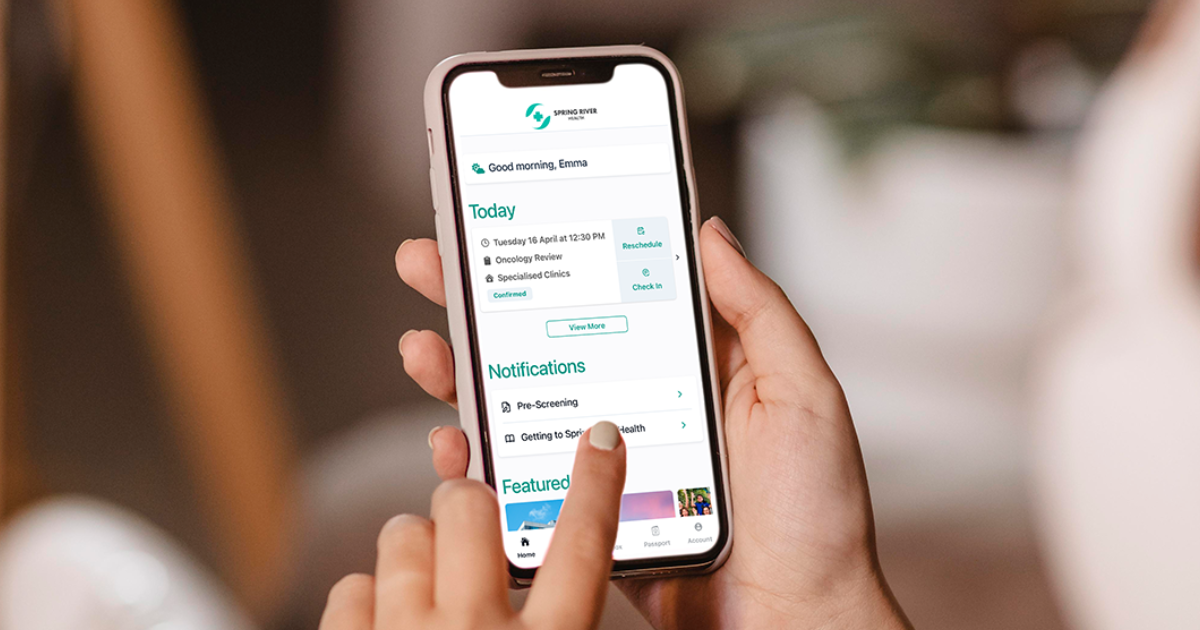The conversation around patient engagement has transformed. Once a buzzword, it’s now a key performance indicator, an essential measure of success for hospital and healthcare providers navigating digital transformation. In a world reshaped by COVID-19, the demand for more intuitive, flexible and accessible healthcare services is no longer aspirational—it’s expected.
That’s where the digital front door comes in.
At its core, a digital front door strategy provides a single access digital platform for patients to begin, manage, and continue their healthcare journey. From appointment bookings and online payments to secure messaging, telehealth appointments, and automated reminders, it’s an integrated, virtual care entry point that reduces friction and puts control back in the hands of patients.
But how does it really improve patient engagement—and why should we care?
In some cases, the financial impact of missed appointments can be huge, affecting both revenue and operational efficiency. Studies at Australian hospitals have shown:
🔹 At one hospital, patients who failed to attend (FTA) their appointment made up 23%. This equated to 2,500+ wasted appointments per year.
🔹 FTA rates generally have been found to be as high as 30%.
🔹 160,000 outpatient appointments were FTA at public hospital clinics over 12 months, resulting in $26m in lost productivity.
These challenges highlight the importance of effective patient engagement solutions like a digital front door.
Let’s take a closer look at how digital front doors are changing the healthcare landscape for the better
What is a Digital Front Door?
A Digital Front Door is a comprehensive digital platform designed to revolutionise how patients interact with healthcare services. It serves as a single access point, streamlining the patient experience by making it more efficient, personalised, and supportive. By integrating various healthcare services into one cohesive system, the Digital Front Door simplifies the patient journey from start to finish.
Whether it’s booking outpatient appointments, preparing for surgery, or engaging in telehealth consultations, this digital gateway ensures patients have seamless and convenient access to the care they need. As a cornerstone of digital transformation in healthcare, having a Digital Front Door strategy in place aims to enhance patient engagement, improve outcomes, and create a more efficient healthcare system.
From Queue to Click: Simplifying Access with a Single Digital Platform
The healthcare system is notoriously complex. Between departments, specialists, and administration, patients often encounter a maze of disconnected touchpoints. A digital front door cuts through the noise, offering a single access platform where patients can easily navigate their healthcare journey, from checking in for appointments to viewing results, accessing billing information, or communicating with their care team. Additionally, the collection of patient information through digital smart forms streamlines the gathering of data, enhancing clinical workflows and improving patient experience.
It’s not just convenient; it’s empowering. When patients feel supported to self-manage aspects of their care, they become more engaged and proactive in decision-making. Ultimately leading to better outcomes, both clinically and experientially.
A Post-COVID Imperative: Why Now?
The pandemic was a turning point. Lockdowns and distancing protocols exposed the limitations of face-to-face-only healthcare and forced rapid innovation. Many of the digital solutions implemented during COVID-19 – like telehealth, secure messaging and digital consent management – weren’t just stopgaps. They were previews of a more scalable, inclusive healthcare system with better digital access for patients.
Now, as the healthcare industry adapts to a hybrid model of care, the digital front door has emerged as the foundation for delivering virtual care while still maintaining the personal touch that patients value.
Enhancing the Patient Experience

At Five Faces, we’ve seen first-hand how the digital front door, which is typically a SaaS solution, elevate the hospital and healthcare experience. When administrative burdens are lifted, patients aren’t left standing by their mailbox, waiting on hold or in queues. Instead, they’re welcomed into a streamlined, intuitive environment that respects their time, privacy, and autonomy.
Features like secure messaging, online check-in, and digital payments reduce the touchpoints that traditionally cause friction. When these interactions happen on familiar devices like phones, tablets, and computers, engagement becomes second nature.
Telehealth and the Future of Patient Access
Telehealth integration remains one of the most valued features of any digital front door. For patients in rural areas, those managing chronic conditions, or those simply unable to attend in person due to work or family commitments, the ability to access services virtually can be life-changing.
And for clinicians, it allows for more adaptive workflows and the potential to scale services sustainably. When coupled with tools for digital documentation, medicines management, and clinical insights, the telehealth experience becomes more than a video call—it becomes a full-service channel of care.
The Link Between Engagement and Outcomes
When patients feel more in control of their healthcare experience, they’re more likely to show up, follow through, and engage meaningfully with their care plans. This isn’t just anecdotal—it’s supported by data.
The Strategic Benefits for Healthcare Providers

Self-Scheduling = Better Access + Better Use of Staff Time
Appointment bookings through the front door eliminate the need for back-and-forth phone calls, reducing pressure on frontline teams while giving patients the flexibility to book when it suits them, whether it be after hours, on weekends, or during a work break.
By integrating automated reminders and queue management tools, clinics and hospitals can also reduce no-show rates, improve punctuality, and create a more efficient experience for both patients and providers. The result? Staff time is freed up to focus on what matters most: patient care.
Digital forms not only ensure data is immediately available without data entry, but also afford patients privacy and often the choice to complete forms from home rather than in a crowded waiting room.
Task Automation for Smarter, More Efficient Care
Behind the scenes, task automation is where a digital front door truly shines. Routine tasks—like appointment reminders, form completion, and appointment outcome forms—can be fully digitised and streamlined, reducing human error and increasing efficiency across the board.
This kind of automation doesn’t just support the business side of healthcare—it supports clinicians, too. With fewer interruptions and less manual processing, providers can spend more time doing what they do best: engaging with patients.
Putting Patient Engagement Into Practice
A well-executed digital front door strategy isn’t just a tech upgrade; it’s a meaningful shift in how we deliver, manage and experience care.
By using a single-access digital solution, hospitals and healthcare providers can simplify the patient journey from start to finish. Tools like self-scheduling, automated reminders and queue management help ease the load on staff while giving patients more flexibility and visibility over their care.
Telehealth appointments make it easier for patients to access services when they can’t attend in person, and features like secure messaging, digital consent forms and online payments help build trust, cut out frustration and lift engagement. On top of that, automating everyday admin tasks gives clinicians more time to focus on what matters most: providing quality care.
In short, digital front doors don’t just improve the patient experience. They make healthcare services more efficient, reduce missed appointments and help drive better outcomes across the board.
Best Practice Tips for Rolling Out a Digital Front Door
A successful digital front door rollout isn’t just about picking the right platform – it’s about making sure it works for your patients, your healthcare staff and your systems. Here are a few practical steps to help set your strategy up for success:
Start with a clear view of where you are.
Take stock of your current systems, services and workflows. Understanding what’s working – and what’s not – will help you spot the gaps and set realistic goals.
Know what success looks like.
Whether you’re aiming to boost patient engagement, reduce wait times or streamline care coordination, having clear goals helps keep your rollout focused and on track.
Choose technology that fits.
Look for technology that’s secure, scalable, and easy to integrate with your existing digital systems. The right solution will grow with your organisation and support long-term change.
Bring people along for the journey.
Engage clinicians, staff and patients early on. Their insights and feedback are key to designing a system that feels intuitive and genuinely supports the way care is delivered.
Plan for change.
Communicate early, provide training, and make space for feedback. Change management doesn’t need to be complicated – it just needs to be thoughtful.
Keep an eye on the data.
Track what’s working and what isn’t. Patient feedback, platform analytics, and staff insights will all help guide ongoing improvements. Make sure you set benchmarks before you roll out new technology!
Stay ahead of the curve.
Digital access is evolving fast. Keep tabs on new technologies, industry trends and consumer expectations so your digital front door continues to deliver value well into the future.

Get in Touch
Looking to streamline patient engagement and improve access across your healthcare services?
The Five Faces team is here to support your journey.
Get in touch to explore how our tailored digital front door solution can help your organisation deliver smarter, more connected care.



